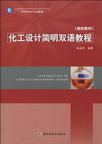化工设计简明双语教程
2010-4
中国轻工业出版社
秦益民
152
236000
无
双语教学是通过用非母语的表达方式来解释和理解专业知识的概念、内容和思想的一种教学方式,其主要目的之一是培养学生熟练地用外语学习知识和思考问题,从“学外语”过渡到“用外语”。自2001年国家教育部颁发文件,明确要求高校在公共和专业课实行以汉语和英语为授课语言的双语教学开始,全国许多高校对双语教学进行了各种形式的尝试和实践,在培养学生使用外语、开阔学生的视野等方面起到了很好的成效。双语教学为学生提供了一个输出语言的机会,培养了学生用两种语言进行思维的能力。在双语教学中,学生开始把英语作为一种传播知识的媒介,而不是知识本身。从这一点上看,双语教学是学以致用的开始,对大学生综合素质的培养有着十分重要的作用。双语教学的目的体现在知识目标、语言目标和思维目标上,即学生对学科知识的掌握、对英语的熟练应用、以及用英语的思维方式进行学习和思考。在双语教学的实施过程中,良好的教学效果受学生的英语水平、授课教师的综合素质、教学环境、办学设施、教材、课程设置、考试方式等因素的影响。在一系列制约双语教学质量的因素中,教材的质量尤为重要。目前国内高校普遍采用国外原版教材作为英文教材。在教学过程中发现,尽管这类教材内容丰富,但是作为本科教材,一些内容过于深奥,学生不易理解。另外,由于国情的不同,对于相同的专业知识,中文教材及英文教材中的一些内容差别比较大,容易使学生思想产生混淆,达不到很好的教学效果。《化工设计》是一门综合应用性很强的专业基础课,是化工及相关类专业学生在掌握化工基础理论知识后,向工程技术领域转化的一个重要环节。它是对各门化工专业基础课程回顾和总结后,运用于工艺设计、工程设计的一门十分重要的应用课程,在化学、化工、材料、生化等技术领域的科研成果转化为现实生产力的过程中起到桥梁和纽带的作用。为了在《化工设计》课程中开展双语教学,本书用英语介绍了化工设计中涉及的原理、规范、程序和方法,包括化工设计项目的可行性研究、厂址选择、工艺流程设计、物料衡算和能量衡算、化工设备的设计和选型、车间布置设计等设计内容,以及化工工艺设计中涉及的安全、环境及经济评价等问题。本书在编者多年从事《化工设计》课程双语教学的基础上,把国外及国内关于化工设计的主要内容进行了整合,从概念设计开始到项目的经济评价,用英语完整地介绍了化工设计中各个阶段的设计内容、原理及方法。本书结合了编者在国外高科技公司多年从事新产品开发的经验,在书中加入了新产品开发过程的内容,与化工新工艺设计的内容整合后,可以使学生更好地理解《化工设计》课程的主要内容。本书在用英文编制完整的教材的同时,对书中涉及的有关化工设计的主要英语词汇及短语用中文标出,在方便学生掌握学科知识的同时,达到双语教学的知识目标、语言目标和思维目标,真正使英语成为教与学的工具。
为了在《化工设计》课程中开展双语教学,本书用英语介绍了化工设计中涉及的原理、规范、程序和方法,包括化工设计项目的可行性研究、厂址选择、工艺流程设计、物料衡算和能量衡算、化工设备的设计和选型、车间布置设计等设计内容,以及化工工艺设计中涉及的安全、环境及经济评价等问题。本书在编者多年从事《化工设计》课程双语教学的基础上,把国外及国内关于化工设计的主要内容进行了整合,从概念设计开始到项目的经济评价,用英语完整地介绍了化工设计中各个阶段的设计内容、原理及方法。本书结合了编者在国外高科技公司多年从事新产品开发的经验,在书中加入了新产品开发过程的内容,与化工新工艺设计的内容整合后,可以使学生更好地理解《化工设计》课程的主要内容。
1 An overview of chemical engineering design 1.1 Chemical engineering design 1.2 Historical background of chemical engineering 1.3 Contemporary chemical engineering 1.4 Ethics of chemical engineering design 1.5 Outline of the present book2 An introduction to chemical product development 2.1 Product development in the chemical industry 2.2 Product development process 2.3 Product development capabilities 2.4 Product development strategy 2.5 Management of a product development project3 Introduction to chemical process design 3.1 Introduction 3.2 Beginning of the design process 3.3 Process design team 3.4 Preliminary investigation 3.5 Procedure for the design of a chemical engineering process 3.6 Project documentation 3.7 Codes and standards4 Feasibility study and report 4.1 Types of feasibility study report 4.2 Feasibility study 4.3 Technical feasibility of a chemical engineering design project 4.4 Economic feasibility of a chemical engineering design project 4.5 Contents of a feasibility study report 4.6 How to write a good feasibility study report5 Site Selection 5.1 Introduction 5.2 Factors for site selection 5.3 Site selection procedure 5.4 Case analysis:site selection criteria for the medical device industry6 Process flow chart design 6.1 Introduction 6.2 Database for the design process 6.3 Procedure for the design of a process flow chart 6.4 Basics of a process flow chart7 Fundamentals of mass balancing 7.1 Introduction 7.2 Objectives of mass balance 7.3 General principle of mass balance 7.4 Units used to express compositions 7.5 Basis for calculations 7.6 Stoichiometry 7.7 Conversion and yield 7.8 Procedure for mass balance calculations8 Fundamentals of energy balancing 8.1 Forms of energy 8.2 Energy balance 8.3 Conservation of energy 8.4 The energy balance9 Design of chemical equipment 9.1 Type of chemical equipment 9.2 Principles for the design of chemical equipment 9.3 General procedures for the design of an item of equipment 9.4 Additional design considerations 9.5 Case analyses of mechanical design for specific equipment 9.6 Design of piping system 9.7 Commissioning and verification of plant equipment10 Plant and equipment layout 10.1 Introduction 10.2 Scope of plant layout 10.3 Methods of plant layout 10.4 Equipment layout 10.5 Safety issues during plant layout11 Safety considerations in chemical engineering design 11.1 Introduction 11.2 Safety and loss prevention 11.3 The hazards 11.4 Dow fire and explosion index 11.5 Safety procedures 11.6 Safety regulations12 Environmental considerations in chemical engineering design 12.1 Introduction 12.2 Environmental issues 12.3 Environmental considerations during process design 12.4 Environmental impact assessment 12.5 EIA reports 12.6 EIA policies around the world13 Economic evaluation of a chemical engineering design project 13.1 Introduction 13.2 Project valuation 13.3 Capital cost estimation 13.4 Operating costs 13.5 Profitability analysisReferences
插图:In order to build up the capabilities that are necessary for developing quality products, chemicalcompanies have to complement its own capabilities with external sources of capabilities, where in-house development lacks economy of scale. More importantly, in a dynamic product market,external sources of capabilities are essential, since a fixed set of internal capabilities may not beflexible enough to cope with the pace of market and technology changes. Strategic alliances (SA,战略联盟) in various forms are therefore essential for the NPD process.SA can bring a number of benefits, such as transfer of technology, technological complementarities, technology exchange, spreading risks and cost of R&D, access to facilities, etc.There are two basic motives for SA. The first is cost sharing to share fixed cost, realize economy of scale and avoid wasteful duplications. The second is skill sharing to benefit complementary knowledge that results from market failure in the NPD input market. For example, firms may have specialized personnel whose skills and knowledge, due to .contractual and confidential arrangements, may not be available in the market. Some important NPD results may be kept awayfrom public access. In these cases, SA provides an important method for outside firms to access afirm's unique resources, which may become the seed of innovation, when fused with technologiesfrom the outside finns. During the development of chemical products, a firm's technology requirement can be divided into three categories:(1)Core technology(核心技术):which gives the potential product its unique competitive advantage. For example, in the case of a highly absorbent wound dressing, the core technology is the polymer chemistry that gives the dressing its inherent high absorption capacity over rival products.
《化工设计简明双语教程》:高等学校专业教材

无
名字叫化工设计简明双语教程。拿到手才知道书中只有一些专业用语标注了中文。其它的都是英语。本来买回来是双语一起学习的,这下好了,等于没有用。****
还不如老老实实就叫化工设计英语教程
就是内容有点少,真是简明教程